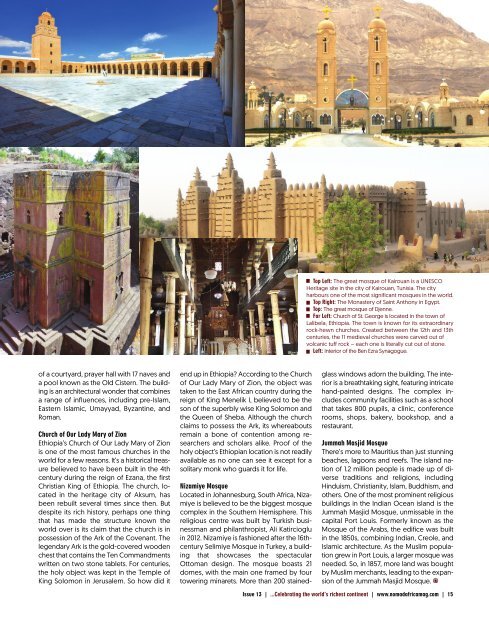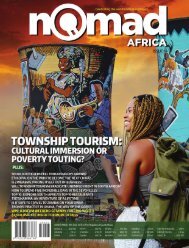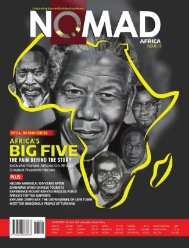Nomad Africa Edition 13
This edition of the magazine presents us with an opportunity to deeply look into faith-based tourism and churches across the continent of Africa. Reports of pastors convincing worshipers to eat snakes, spraying insecticide into mouths of believers during fully packed sermons under the guise of God’s hand apparently, and even buildings that collapse due to poor structural engineering – there has been much strange activity, but no consequence. This makes us ask a single question; should churches not be regulated? (see page 76). Lorraine Masemola – a new addition to our editorial team, attended the Domba traditional dance of magical Venda in South Africa. This colourful python dance, held annually at a very sacred site, Lake Fundudzi, secures good rain for the following season (page 52). In another special feature, Martin Chemhere, in his piece, updates us on South Africa’s newly relaxed visa regulations. Will it significantly help boost tourism in that country? (page 62). To this extent, I will like to say that I am delighted to work with the talented team here at Nomad Africa as I assume the position as the new Managing Editor. It was a daunting idea to build something new in travel journalism - something brave, bold and exceptionally beautiful. Africa’s future is an open road and we’re picking up speed, so it is the perfect time to be joining. Good writing and engaging storytelling are the lenses through which we connect with the world. I look forward to exploring the various cultures, people, developments and trends impacting Africa’s travel and tourism industry. At a time when most online content tends toward the shallow and ephemeral, our stories will seek to deliver sustained engagement and value. As I work with the team to grow the company into a sustainable publisher of smart stories, dynamic insights and carefully curated thought leadership, I hope you find it resourceful and compelling. I am grateful to re-imagine every single page with you. I look forward to the journey. I hope you enjoy the ride with us.
This edition of the magazine presents us with an opportunity to deeply look into faith-based tourism and churches across the continent of Africa. Reports of pastors convincing worshipers to eat snakes, spraying insecticide into mouths of believers during fully packed sermons under the guise of God’s hand apparently, and even buildings that collapse due to poor structural engineering – there has been much strange activity, but no consequence. This makes us ask a single question; should churches not be regulated? (see page 76).
Lorraine Masemola – a new addition to our editorial team, attended the Domba traditional dance of magical Venda in South Africa. This colourful python dance, held annually at a very sacred site, Lake Fundudzi, secures good rain for the following season (page 52). In another special feature, Martin Chemhere, in his piece, updates us on South Africa’s newly relaxed visa regulations. Will it significantly help boost tourism in that country? (page 62).
To this extent, I will like to say that I am delighted to work with the talented team here at Nomad Africa as I assume the position as the new Managing Editor. It was a daunting idea to build something new in travel journalism - something brave, bold and exceptionally beautiful. Africa’s future is an open road and we’re picking up speed, so it is the perfect time to be joining.
Good writing and engaging storytelling are the lenses through which we connect with the world. I look forward to exploring the various cultures, people, developments and trends impacting Africa’s travel and tourism industry. At a time when most online content tends toward the shallow and ephemeral, our stories will seek to deliver sustained engagement and value. As I work with the team to grow the company into a sustainable publisher of smart stories, dynamic insights and carefully curated thought leadership,
I hope you find it resourceful and compelling. I am grateful to re-imagine every
single page with you. I look forward to the journey. I hope you enjoy the ride with us.
Create successful ePaper yourself
Turn your PDF publications into a flip-book with our unique Google optimized e-Paper software.
Top Left: The great mosque of Kairouan is a UNESCO<br />
Heritage site in the city of Kairouan, Tunisia. The city<br />
harbours one of the most significant mosques in the world.<br />
Top Right: The Monastery of Saint Anthony in Egypt.<br />
Top: The great mosque of Djenne.<br />
Far Left: Church of St. George is located in the town of<br />
Lalibela, Ethiopia. The town is known for its extraordinary<br />
rock-hewn churches. Created between the 12th and <strong>13</strong>th<br />
centuries, the 11 medieval churches were carved out of<br />
volcanic tuff rock – each one is literally cut out of stone.<br />
Left: Interior of the Ben Ezra Synagogue.<br />
of a courtyard, prayer hall with 17 naves and<br />
a pool known as the Old Cistern. The building<br />
is an architectural wonder that combines<br />
a range of influences, including pre-Islam,<br />
Eastern Islamic, Umayyad, Byzantine, and<br />
Roman.<br />
Church of Our Lady Mary of Zion<br />
Ethiopia’s Church of Our Lady Mary of Zion<br />
is one of the most famous churches in the<br />
world for a few reasons. It’s a historical treasure<br />
believed to have been built in the 4th<br />
century during the reign of Ezana, the first<br />
Christian King of Ethiopia. The church, located<br />
in the heritage city of Aksum, has<br />
been rebuilt several times since then. But<br />
despite its rich history, perhaps one thing<br />
that has made the structure known the<br />
world over is its claim that the church is in<br />
possession of the Ark of the Covenant. The<br />
legendary Ark is the gold-covered wooden<br />
chest that contains the Ten Commandments<br />
written on two stone tablets. For centuries,<br />
the holy object was kept in the Temple of<br />
King Solomon in Jerusalem. So how did it<br />
end up in Ethiopia? According to the Church<br />
of Our Lady Mary of Zion, the object was<br />
taken to the East <strong>Africa</strong>n country during the<br />
reign of King Menelik I, believed to be the<br />
son of the superbly wise King Solomon and<br />
the Queen of Sheba. Although the church<br />
claims to possess the Ark, its whereabouts<br />
remain a bone of contention among researchers<br />
and scholars alike. Proof of the<br />
holy object’s Ethiopian location is not readily<br />
available as no one can see it except for a<br />
solitary monk who guards it for life.<br />
Nizamiye Mosque<br />
Located in Johannesburg, South <strong>Africa</strong>, Nizamiye<br />
is believed to be the biggest mosque<br />
complex in the Southern Hemisphere. This<br />
religious centre was built by Turkish businessman<br />
and philanthropist, Ali Katircioglu<br />
in 2012. Nizamiye is fashioned after the 16thcentury<br />
Selimiye Mosque in Turkey, a building<br />
that showcases the spectacular<br />
Ottoman design. The mosque boasts 21<br />
domes, with the main one framed by four<br />
towering minarets. More than 200 stainedglass<br />
windows adorn the building. The interior<br />
is a breathtaking sight, featuring intricate<br />
hand-painted designs. The complex includes<br />
community facilities such as a school<br />
that takes 800 pupils, a clinic, conference<br />
rooms, shops, bakery, bookshop, and a<br />
restaurant.<br />
Jummah Masjid Mosque<br />
There’s more to Mauritius than just stunning<br />
beaches, lagoons and reefs. The island nation<br />
of 1.2 million people is made up of diverse<br />
traditions and religions, including<br />
Hinduism, Christianity, Islam, Buddhism, and<br />
others. One of the most prominent religious<br />
buildings in the Indian Ocean island is the<br />
Jummah Masjid Mosque, unmissable in the<br />
capital Port Louis. Formerly known as the<br />
Mosque of the Arabs, the edifice was built<br />
in the 1850s, combining Indian, Creole, and<br />
Islamic architecture. As the Muslim population<br />
grew in Port Louis, a larger mosque was<br />
needed. So, in 1857, more land was bought<br />
by Muslim merchants, leading to the expansion<br />
of the Jummah Masjid Mosque.<br />
Issue <strong>13</strong> | ...Celebrating the world’s richest continent | www.nomadafricamag.com | 15





